 |
 |
 |
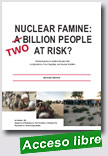 |
Global Impacts of Limited Nuclear War on Agriculture, Food Supplies, and Human Nutrition
International Physicians for the Prevention of Nuclear War, November 2013, 23 p.
The newly generated data on the decline in agricultural production that would follow a limited, regional nuclear war in South Asia support the concern that more than two billion people would be in danger of starvation.
Epidemic disease and further conflict spawned by such a famine would put additional hundreds of millions at risk. These findings support the following recommendations:
|
There is an urgent need for further study to confirm the declines in corn and rice production predicted by Ozdogan and Xia, and to examine the effect on other key crops, such as wheat, and in other important food producing countries; there is a need to explore in more detail the subsequent effects that these shortfalls would have on human nutrition including both the
extent of the decline in caloric intake that would result from these crop losses and the extent of micronutrient deficiencies that would, in turn, result from this decline in caloric intake;
the need for further study notwithstanding, the preliminary data in these studies raises a giant red flag about the threat to humanity posed not only by the nuclear arms race in South Asia but also by the larger and more dangerous nuclear arsenals possessed by the other nuclear weapons states. These studies demonstrate the need for additional research and underscore the urgent need to move with all possible speed to the negotiation of a global agreement to outlaw and eliminate nuclear weapons and the danger of nuclear war.
Executive Summary
Extraído de: http://www.ippnw.org/pdf/nuclear-famine-2013-summary-english.pdf
|
 |
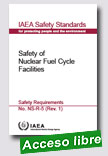 |
Safety of Nuclear Fuel Cycle Facilities
IAEA Safety Standards Series, 2014, 102 p.
This publication covers the broad scope of requirements for fuel cycle facilities that, in light of the experience and present state of technology, must be satisfied to ensure safety for the lifetime of the facility. Topics of specific relevance include aspects of nuclear fuel generation, storage, reprocessing and disposal. |
Extraído de: http://www-pub.iaea.org/books/IAEABooks/10708/Safety-of-Nuclear-Fuel-Cycle-Facilities
|
 |
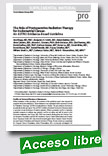 |
The Role of Postoperative Radiation Therapy for Endometrial Cancer: An ASTRO Evidence-Based Guideline
American Society for Radiation Oncology (ASTRO), 2014, 22 p.
To present evidence-based guidelines for adjuvant radiation in the treatment of endometrial cancer.
Methods and materials: Key clinical questions to be addressed in this evidence-based guideline on endometrial cancer were identified. A comprehensive literature review was performed to identify studies that included no adjuvant therapy, or pelvic |
.and/or vaginal brachytherapy with or without systemic chemotherapy. Outcomes included local control, survival rates, and overall assessment of quality of life.
Extraído de: http://download.journals.elsevierhealth.com/mmcs/journals/1879-8500/PIIS1879850014000058.mmc1.pdf |
 |
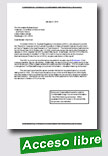 |
This report has been prepared in response to the National Defense Authorization Act for Fiscal Year 2013 (Public Law 112-239) (NDAA 2013), which was signed into law by President Obama on January 2, 2013. Specifically, Title XXXI, Subtitle F of the NDAA 2013 contains the American Medical Isotopes Production Act of 2012, which, in Section 3175, |
“Report on Disposition of Exports,” requires the following: Not later than 1 year after the date of the enactment of this Act, the Chairman of the Nuclear Regulatory Commission, after consulting with other relevant agencies, shall submit to the Congress a report detailing the current disposition of previous United States exports of highly enriched uranium used as fuel or targets in a nuclear research or test reactor, including—(1) their location; (2) whether they are irradiated; (3) whether they have been used for the purpose stated in their export license;(4) whether they have been used for an alternative purpose and, if so, whether such alternative purpose has been explicitly approved by the Commission; (5) the year of export, and reimportation, if applicable; (6) their current physical and chemical forms; and (7) whether they are being stored in a manner which adequately protects against theft and unauthorized access.
This Nuclear Regulatory Commission (NRC) report provides the information requested based on available records from various sources dating back to 1950. It also includes background information describing key features of the legal and institutional framework governing United States (U.S.) exports of highly enriched uranium (HEU) and indicates how some of the features have changed over the years.1 The report focuses on the current disposition of the HEU exported from the United States for use as fuel or targets in research and test reactors (RTRs).
Information on HEU exported for purposes other than use as fuel or targets in RTRs is not included in this report based on the direction in Section 3175 of the NDAA 2013.
Extraído de:
http://fissilematerials.org/library/nrc14.pdf
|
 |
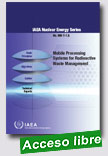 |
Mobile Processing Systems for Radioactive Waste Management
IAEA Nuclear Energy Series, 2014, 106 p.
In recent years, mobile systems have increasingly been deployed for the processing of different types of radioactive waste. Such systems offer flexibility in selection and application of the optimum technology for a specific waste stream by bringing the process to the point where the waste is generated, with the additional benefit that there can be equipment sharing among multiple generating sites. This publication provides the basic information on utilization of
|
mobile systems for waste processing and introduces a methodology for the assessment required to determine the viability of mobile systems for specific applications. In addition, it informs the reader on the accurate assessment of mobile systems that employ one or more technologies. The target audience is professionals involved in the planning, selection, design, deployment and regulation of radioactive waste processing facilities.
Extraído de:
http://www-pub.iaea.org/books/IAEABooks/10438/Mobile-Processing-Systems-for-Radioactive-Waste-Management
|
 |
 |
Cost Estimation for Research Reactor Decommissioning
IAEA Nuclear Energy Series, 2014, 95 p.
The main aim of this publication is to disseminate experience in and guidance on cost estimates for research reactor decommissioning projects. It presents the principles and background for a costing methodology based on the International Structure for Decommissioning Costing (ISDC) of Nuclear Installations. The methodology presented implements actual experience in decommissioning costing and is in line with IAEA efforts promoting harmonization in this field. The IAEA
|
has contributed to the development of software called CERREX (Cost Estimate for Research Reactors in Excel), a simpler version suitable for preliminary costing stages, which is included on the attached CD-ROM, together with a user manual. Several practical examples of software implementation and clarification of some details of available methodologies and models are also provided.
Extraído de: http://www-pub.iaea.org/books/IAEABooks/10381/Cost-Estimation-for-Research-Reactor-Decommissioning
|
 |

|
The Environmental Behaviour of Radium: Revised Edition
IAEA Technical Reports Series, 2014, 267 p.
This publication aims to provide IAEA Member States with information for use in the radiological assessment of accidental releases and routine discharges of radium in the environment. It covers radium behaviour in the terrestrial, freshwater and marine environments. The information presented is relevant to the transfer of radionuclides through food chains to both humans and non-human biota. The corresponding remedial options and regulating aspects are
|
also within the scope of this publication. Additionally, applications of radium isotopes to environmental issues are discussed in order to alert readers to studies that use radium isotopes as tracers of environmental processes. The information could also serve as a basis for remediation planning and identification of optimal remediation strategies in areas contaminated by radium.
Extraído de: http://www-pub.iaea.org/books/IAEABooks/10478/The-Environmental-Behaviour-of-Radium-Revised-Edition
|
 |
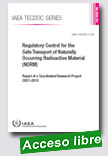 |
Regulatory Control for the Safe Transport of Naturally Occurring Radioactive Material (NORM)
IAEA TECDOC, 2014, 63 p.
This publication presents the outcome of an IAEA coordinated research project (CRP), which was organized to identify the types of NORM materials transported and the resulting radiation doses to workers and the public as a result of transport. The CRP participants reviewed a wide range of materials from NORM industries, including those used for extraction of minerals, direct use materials, scales from oil and |
gas extraction industries, ores and waste material from uranium processing and other materials. They also conducted surveys of industries involved in the transport of NORM and assessed doses to workers and members of the public through modelling and by direct measurement. The results of the studies and several conclusions about regulatory provisions that should be more closely aligned with expected doses during transport were agreed upon by all participants, and are presented in this publication. Individual country reports are available for review in the accompanying CD-ROM. In addition, the recommendations of this CRP have been reflected in the 2012 edition of the Transport Regulations and associated Safety Guides.
Extraído de:
http://www-pub.iaea.org/books/IAEABooks/10440/Regulatory-Control-for-the-Safe-Transport-of-Naturally-Occurring-Radioactive-Material-NORM
|
 |
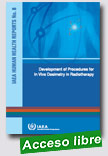 |
Development of Procedures for In Vivo Dosimetry in Radiotherapy
IAEA Human Health Reports, 2013, 179 p.
This publication, which draws on the experiences of an IAEA coordinated research project (CRP) and on input from experts in the field, provides a comprehensive overview of the development of procedures for in vivo dosimetry in radiotherapy. It elaborates on the technology behind in vivo dosimetry and describes an initial set of in vivo measurements. Emphasis is given to patient dose studies,
|
both evaluating the clinical value of in vivo dosimetry and comparing different in vivo dosimetry systems in a clinical setting. The findings of the CRP, which are summarized in this publication, will serve as a useful resource for hospital physicists seeking to establish an in vivo dosimetry programme in a radiotherapy centre and will help them in the selection of appropriate in vivo dosimetry systems.
Extraído de:
http://www-pub.iaea.org/books/IAEABooks/8962/Development-of-Procedures-for-In-Vivo-Dosimetry-in-Radiotherapy
|
 |
|
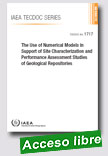
|
The Use of Numerical Models in Support of Site Characterization and Performance Assessment Studies of Geological Repositories
IAEA TECDOC, 2014, 134 p.
The overall purpose of this CRP was to transfer technology from Member States with advanced numerical modelling capabilities to Member States currently evaluating the use of such technologies in support of site characterization activities, design of field and laboratory experiments, data analyses by means of inverse modelling, and total system performance analyses.
|
The modelling approach was demonstrated and optimized by developing a numerical model suitable for predicting a specific aspect of the repository system. The issue of interest was identified by the participating Member States, and available data and information from those States were used in the demonstration. The studies focused on (1) the use of sophisticated numerical modelling tools as a means to integrate existing data into a conceptual understanding of the repository system, (2) the use of these models for predictive purposes, and (3) the development of recommendations for future test design and data collection
activities, driven by the need to reduce prediction uncertainties of key components of the natural system.
The specific objectives of this CRP are for participating Member States to: Help the participants to develop an integrated data interpretation and modelling approach tailored to the repository concept and geologic conditions of the participating Member States; Acquire expertise in model-development strategies and the use of sophisticated numerical simulators for the reproduction of the observed natural system state and the prediction of the repository system behaviour; Become skilled at using numerical modelling tools for the design of laboratory and field experiments; Examine the advantages and limitations of numerical models for the study of complex coupled processes.
Extraído de:
http://www-pub.iaea.org/MTCD/Publications/PDF/TE-1717_web.pdf |
| |
| |
|
|
| |
| |
|
|
| |
|
|
|
| |
|
|
|
| |
|
